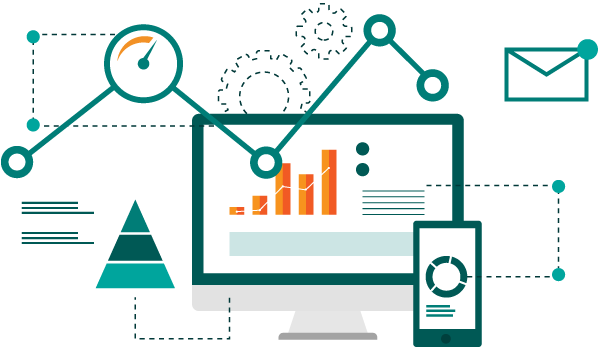Vital Tips for Proper Website Analysis
 Is it time to plan your your companies digital marketing strategies for the next year, or quarter, or month, or even week? Well stop!
Is it time to plan your your companies digital marketing strategies for the next year, or quarter, or month, or even week? Well stop!
Before you can reasonably determine what marketing strategies you should deploy to move your company forward, you first have to understand how your past and current efforts have performed.
And in order to truly determine that, you need to know the real down-and-dirty performance of your website (the hub for all branding, marketing, and lead generation in today’s world).
Are you correctly tracking website performance? By that I mean, do you know the purpose of each page of your site and whether it’s achieving that purpose?
For instance, is the goal of your company About page different from a main product page? Are you tracking it as such?
If you’re evaluating your site performance as a whole — meaning analyzing the entire site as one entity (total site traffic, total conversions, total bounce rate, etc.) — you’re doing yourself a disservice. Certain pages perform differently than others, and to not monitor them individually is to not understand the true extent of your efforts.
Here are some examples to make more sense of this.
Misleading Conversion Rate

For non-ecommerce sites, converting a website visitor via a form, phone call, live chat, or other means is the essential first step to closing a sale. But not all conversions are created equal.
Click Here to Learn More about Conversions
Your Contact Us page may have the highest conversion rate on your site (the ratio of site visitors to leads generated). But is it generating actual actionable leads? Or are converters looking for customer service information or to send a thank you message or to do something else unrelated to sales?
“Be transparent. Visitors are more likely to convert (and become an actionable lead) if they understand the value of an offer. Forms with vague calls-to-action like ‘contact us for help’ are unclear. What help is the visitor receiving? When will the visitor receive help? Define the offer, clearly state who this offer is meant for, and set expectations for receiving the offer.” – Katie Schieder, Inbound Marketing Manager
- Pro-tip 1: Invest in a CRM system or some other way to track leads to sales. Generating hundreds of leads a month sounds great, but the only way to know if you’re reaching the right audience and generating the right leads is if you know how many of those converters became a sale.
- Pro-tip 2: Know what’s realistic when it comes to conversion rate. For ecommerce, 1 percent may be a huge success. If you are giving away a whitepaper for the cost of a form fill in order to capture a lead for a sales person to pursue, you may shoot for closer to 20 percent.
Moz says, “focus on the money and the conversion rate that’s directly linked to revenue.”
Not All Pages Can Convert

Does your About page have an effective conversion point? No? Then don’t judge it based on conversions. Instead consider its goal more of branding and credibility building. Perhaps look more at the average time a user spends on the page to gauge its effectiveness, or if users are visiting multiple pages to absorb your full story. It’s not uncommon for users to last less than 30 seconds on a page, so if you’re keeping them for longer than that, you’re doing something right, and hopefully leaving a lasting impression.
“There should not be a conversion opportunity on every page, but there should be opportunities for a visitor to learn more and be guided through the site with relevant links and content offers. To evaluate where you should place content offers and conversion opportunities, look at how visitors move through your site. Don’t assume your customers navigate your site the same way you do.” – Katie Schieder, Inbound Marketing Manager
- Pro-tip 1: You can set up user flow to see if a converter started on an About page and navigated through the site to eventually become a lead.
- Pro-tip 2: You can take this further by purposely setting up such paths and funnels. Have your non-converting pages link deeper into the site, to pages that are more likely to convert.
High Bounce Rate isn’t Always Bad

Bounce rate is the percentage of visitors who leave a page without going anywhere else in the site. It can be a powerful indicator of content that isn’t resonating with your audience.
A solid bounce rate tends to live in the 40-60 percent range. Bounce rates for blog posts and articles tend to be higher, sometimes 70-80 percent. But a high bounce rate doesn’t necessarily mean a page is failing.
What if the goal of a page is to get users to call a phone number to schedule an appointment — what do you think a user would do after placing that call? You guessed it: leave the site, thereby becoming a bounce. So the moral is that you sometimes need to look at all metrics to understand what’s actually happening. Sometimes one stat doesn’t tell the full story.
“All Metrics are not created equal. And improper interpretation of data can lead to bad marketing decisions. A ‘good’ bounce rate is subjective. Depending on the page and its content, a high bounce rate is perfectly acceptable or even a sign of a healthy website. For instance, a sudden spike in bounce rate may mean that users can find what they need quicker, resulting in less Time-on-Site and fewer Pageviews. The point is this: don’t freak out. Don’t do anything rash. Instead, understand the purpose of the page, consider how users interact with the content, and analyze all pertinent metrics.” – Patrick Coyne, SEO Manager
- Pro-tip 1: When user’s complete forms on your site, send them to a confirmation page with a thank you message. This will mean users hit a page AFTER completing the form, meaning they won’t be recorded as a bounce.
- Pro-tip 2: All your blog posts and articles should link to additional articles or to deeper pages within your site. Don’t let interested readers become bounces — keep them on your site.
Bounce rates can also offer insight and suggestions for improvement. According to Business2Community, “bounce rates can highlight information around the following areas:
- “Keyword and Content Relevance – Are people finding what they’re looking for? Are you targeting the right keyword phrases?
- “Usability – Is your website easy to navigate? Have you made it easy for people to venture deeper into the website? Are your pages loading quickly enough? Are you optimized for mobile?
- “Design – Is your design attractive? Does it contribute positively to your trustworthiness? Are over-prominent ads driving people away?
- “User Behavior – Which of your content pieces are most successful at driving people further into your website and keeping them engaged?
- “Traffic Sources – Which websites are referring visitors that spend time reading content across multiple pages?”
These are just some examples of how metrics should carry different values for different pages. If you aren’t tracking the intent of each page or at least each section, you can’t truly tell what content resonates, what doesn’t, what pages impact results, and what aren’t unnecessary.
As you begin to prepare your next year, or quarter, or month, or week’s digital marketing plan, do yourself a favor and conduct an analysis of the purpose and effectiveness of each specific section of your site. It will help you determine what marketing efforts are working and what should change.
Good luck!


